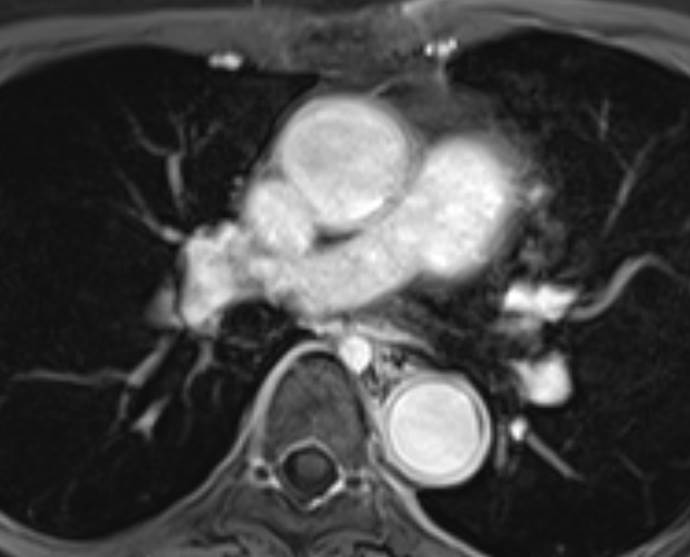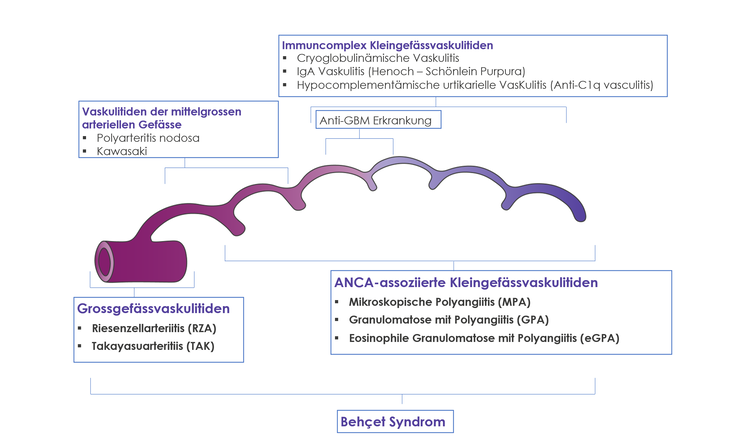News
Vasculitis = inflammation of the blood vessel walls
Vasculitis is what's called a rare disease. Right now, the government is calling for research into rare diseases, faster diagnosis, and new drug therapies.
Vascular inflammation: Types and classification
Inflammation of the vessel wall can affect both arteries (= high pressure vessels that transport blood from the heart to the organs) and veins (= thin-walled vessels that carry blood back to the heart)
.
The classification of the diseases is primarily based on the size of the vessels, for example there is the group of "large vessel vasculitis" or the group of "small vessel vasculitis". A further subdivision is based on the characteristics of the disease, for example the presence of ANCA antibodies in the blood, known as ANCA-associated vasculitis (AAV).
- Giant cell arteritis
- Takayasu arteritis
- ANCA vasculitis
- Behçet's syndrome
Giant cell arteritis
Giant cell arteritis (GCA) is an inflammation of the vessel wall of medium and large arteries. It affects older people from the age of 50, with a steady increase in the likelihood of developing the disease into old age. There are three forms of the disease: the best known is inflammation of the temporal artery (known as arteritis temporalis), which leads to new types of headaches in the temporal region, usually on one side. Visual disturbances such as double vision, distorted vision, color vision and blindness are also typical.

Other symptoms
- New type of headache in the temple area or in the neck
- Visual disturbances
- Pain in the chewing muscles when eating
- Sensitivity of the scalp
- Weight loss
- Fever
The second form is the so-called "polymyalgia rheumatica". This manifests itself as muscle pain in the shoulder girdle and pelvic girdle. Those affected feel ill and completely stiff in the limbs, especially in the morning; for example, they can barely lift their arms to shoulder height. This form of the disease can occur with or without blood vessel involvement.
The third form is an inflammation of the vascular wall of the aorta and the large arterial vessels in the chest and abdomen (so-called Large Vessel Vasculitis LVV). This form can occur without pain, but (almost) invariably leads to a severe feeling of illness, loss of appetite and weight and fever.
Diagnostics
The clinical examination and diagnosis include imaging of the vascular inflammation by means of a tissue sample (so-called biopsy) of a temporal artery (minor surgical procedure), or by means of a new imaging examination:
- Ultrasound examination
- Core spin examination (MR angiography)
- PET-CT (positron emission tomography combined with computed tomography)
MR angiography: contrast agent accumulation in the vessel wall of the descending aorta, 10 minutes after injection of the contrast agent
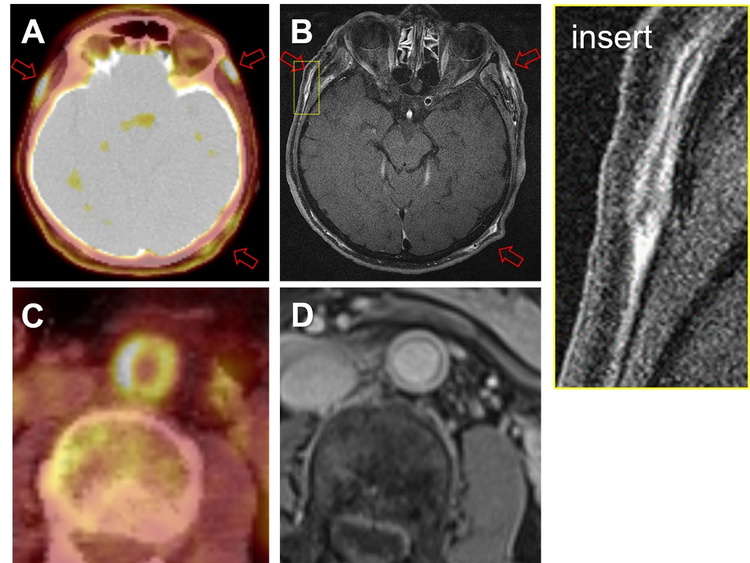
PET-CT (A, C) + MR-Angiographie (dark blood Technik; B, D)
- Oben Querschnitt durch Kopf Höhe Augen: entzündete Gefässe mit Pfeilen markiert
- Unten: Hauptschlagader (Aorta): Wandentzündung (gelber Ring im PET; weisser Ring im MR)
- Insert: Vergrösserung mit gut erkennbarer Entzündung der Arterienwand (weiss dargestellt)
P M Villiger. Large-vessel vasculitis-giant cell and Takayasu arteritis. Internist (Berl). 2019 Oct;60(10):1059-1073
Therapy
Immediate start of therapy with cortisone preparations (prednisone, Spiricort) is important to prevent possible blindness. In an emergency, contact one of the telephone numbers / addresses of the VASAS in your region!
Since cortisone preparations (= glucocorticoids) always lead to adverse effects such as bone loss (osteoporosis), muscle weakness, skin bleeding (especially on the back of the forearm), etc., you should consider the possibility of treatment with tocilizumab (Actemra®) or methotrexate. Actemra® is approved in Switzerland for giant cell arteritis, but requires a cost approval from the health insurance company. If necessary, ask your GP for a referral to a specialist (e.g. a VASAS specialist).
Takayasu arteritis
Takayasu arteritis (TAK) is a very rare disease that causes inflammation of the aorta and the medium and large arterial vessels for an unknown reason.
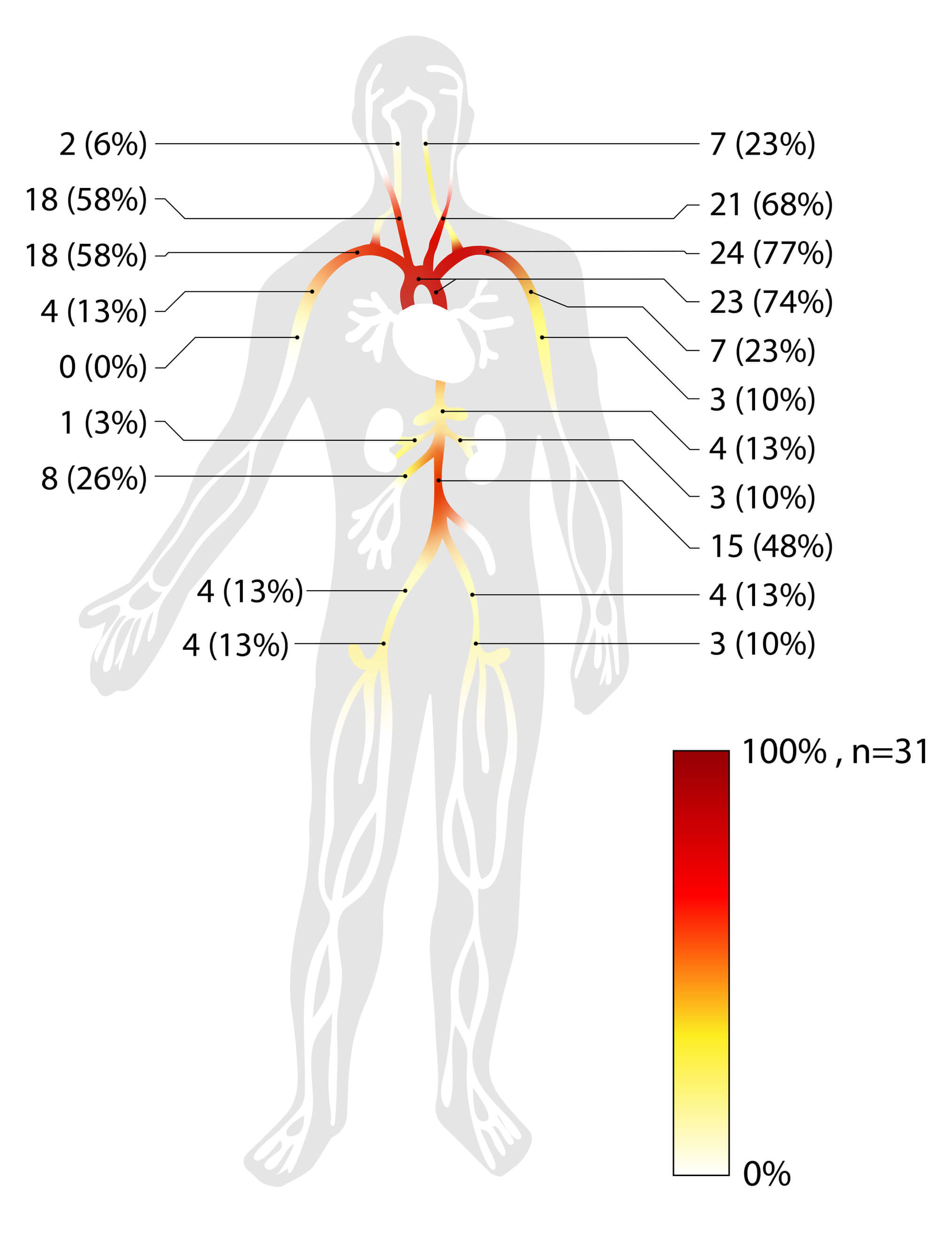
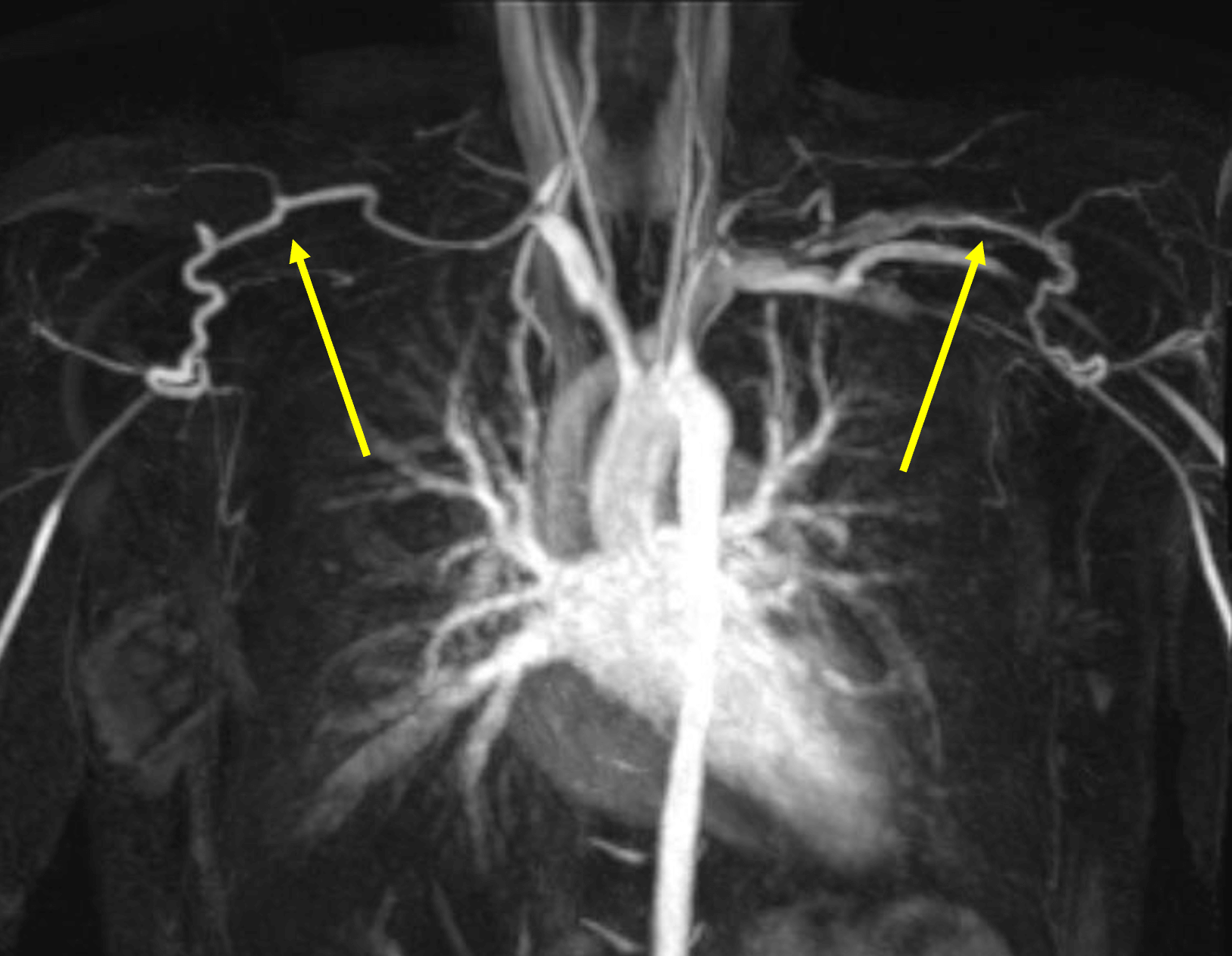
The disease usually begins in childhood or young adulthood. Women are affected much more frequently than men. In Switzerland, the diagnosis is made with an average delay of 9 years. Reference Takayasu
Complaints include tingling, weakness and/or coldness in the arms and legs, pain above the carotid artery, dizziness, visual disturbances and migraine, but also abdominal pain. Tiredness, poor performance and a slightly elevated temperature or fever are often complained about and often interpreted as psychological.
Because of these unspecific symptoms and the absence of pain, the diagnosis is only made when a load-dependent paralysis of an arm occurs (for example when swimming or doing overhead work such as hanging objects).
The usually only slightly elevated inflammatory values in the blood test are striking (CRP repeatedly elevated, but only slightly above the norm in each case, other values normal)
The suspicion is confirmed by an imaging examination, analogous to the examination of giant cell arteritis
- Ultrasound examination
- Core spin examination (MR angiography)
- PET-CT (positron emission tomography combined with computed tomography)
Due to the young age, attempts are made to administer glucocorticoids (cortisone preparations) for as short a time as possible and to use immune preparations such as azathioprine or biologics such as infliximab from the start of treatment. Reference Takayasu
Frequently prescribed remedies are:
- Azathioprine
- Methotrexate
- Leflunomide (original preparation Arava®)
- Mycophenolate mofetil
- TNF inhibitors: primarily infliximab (originator product Remicade®), adalimumab (originator product Humira®) and certolizumab (Cimzia®)
- IL-6 blockers such as tocilizumab (Actemra®) or sarilumab (Kevzara®)
Reference TAK Study: Gloor AD, Chollet L, Christ LA, CullmannJL, Bonel HM, Villiger PM (2021) Takayasu arteritis: Prevalence and clinical presentation in Switzerland. PLoS ONE 16(6): e0250025. https://journals.plos.org/plosone/article?id=10.1371/journal.pone.0250025.
ANCA vasculitis
In contrast to RZA and TAK, ANCA vasculitis affects the small vessels. In contrast to large vessel vasculitis, individual organs such as the kidneys or lungs can be severely affected in ANCA vasculitis. If left untreated, severe kidney dysfunction with dialysis (= kidney replacement procedure) can occur within a short period of time. While TAK affects young people and RZA affects older and elderly people, ANCA vasculitis typically affects people around 50 years of age. However, children and the elderly can also develop the disease.
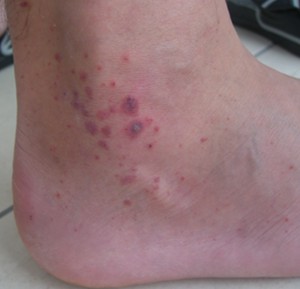
The ANCA-associated vasculitides (AAV) are a group of three diseases (see also figure of the classification).
- Granulomatosis with polyangiitis [GPA; formerly known as Wegener's disease],
- Microscopic polyangiitis [MPA]
- the very rare eosinophilic granulomatosis with polyangiitis [eGPA; formerly called Churg Strauss syndrome]
- .
The term ANCA means that a blood protein, a so-called antibody, is often found in these forms of vascular inflammation, which is directed against the body's own substances in white blood cells (ANCA = Anti - Neutrophil Cytoplasmic Antibody). This antibody plays an important role in the development of the disease.
The first symptoms of GPA usually occur in the nasal and sinus area. The inflammation leads to secretions, often bloody, and travels along the airways into the lungs. If other organs such as the kidneys or the nervous system are affected, ANCA is practically always detectable (so-called ANCA-positive vasculitis)
eGPA typically develops on the basis of an allergic bronchial disease. If the glucocorticoid-containing nasal sprays are no longer sufficient and treatment with prednisone tablets is required, this may be a sign of the onset of eGPA.
MPA is the most insidious form of AAV, as it lacks warning symptoms such as asthma or chronic sinusitis. It is also insidious because the kidneys are affected and do not cause any symptoms such as pain or signs of inflammation.
The investigation of AAV includes blood and urine tests and a systematic examination of all organ systems. If at all possible, a tissue sample is taken (from the kidney in the case of kidney infestation, otherwise also from the skin or lungs). Rapid treatment is also important here, but it is very differentiated and depends on organ involvement, disease activity, prognostic factors and age.

Granulomatosis with polyangiitis: Computed tomography with 2 granulomas in the lung (arrows)
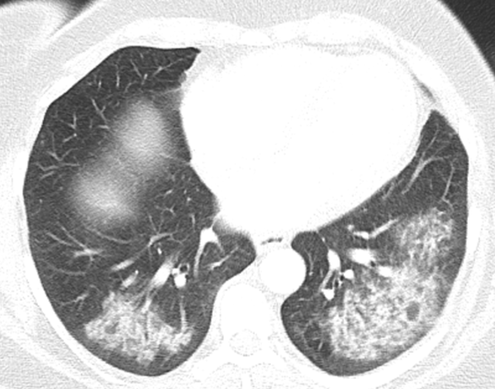
- Granulomatosis with polyangiitis
- voluminous pulmonary hemorrhages on both sides as an expression of active small vessel vasculitis

Typical eye inflammation with active ANCA vasculitis
Behcet Syndrom
Behçet's syndrome (BS) is a chameleon. With a classic clinical presentation, BS is easy to diagnose; with atypical disease, there can be a delay of years (Reference BS). BS can affect all types of vessels, from large arteries to medium and small vessels and large veins such as the vena cava of the trunk. The most dangerous forms are found in young adults, for example vasculitis of the pulmonary vessels, leg arteries or brain infestation.
The NB has a peculiarity that is extremely important in terms of therapy, namely the so-called pathergy phenomenon. This describes the fact that even a minor trauma such as a pinprick can trigger a local inflammation. This characteristic can have serious consequences for vascular surgery, as untreated vascular surgery often leads to serious complications and re-operations.
Interesting is the fact that BS responds well to TNF inhibition (infliximab, adalimumab, etc.) almost without exception. If a suspected BS does not respond to TNF inhibitors, the diagnosis should be checked.
Application example
The good response is illustrated in the illustration of a skin ulcer. After a single injection of adalimumab (40mg), the chronic ulcer disappeared and the planned operation could be canceled.

shows a skin ulcer that did not respond to normal therapy.

And after therapy with 1 ampoule of adalimumab 40 mg
Spread of Behçet's syndrome
Countries with high prevalence shown in red. Behçet's syndrome has spread along the (former) Silk Road.
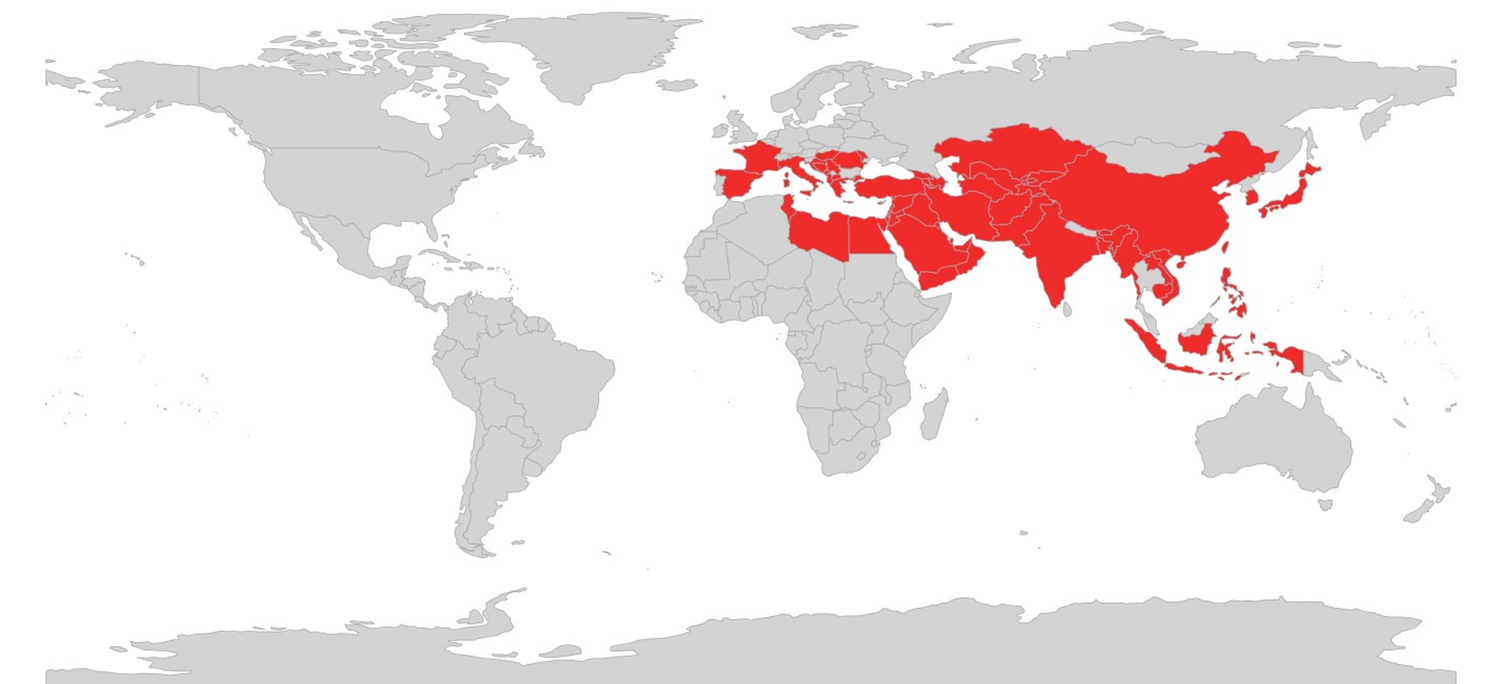
The article on BS in Switzerland provides information on organ involvement and complaints.
Reference BS: Behçet’s syndrome: clinical presentation and prevalence in Switzerland
Villiger Rahel A., Stefanski Anna-Luisa, Grobéty Véronique, Adler Sabine, Villiger Peter M. Swiss Med Wkly. 2019;149:w20072. Doi:20.4414/smw.2019.20072.
https://smw.ch/index.php/smw/article/view/2654
Individual support for those affected and specialists
We offer targeted information and support for both those affected and professionals. If you are affected yourself, you will find clear explanations and helpful services here. Professionals receive in-depth specialist information and resources to optimally support their work.

